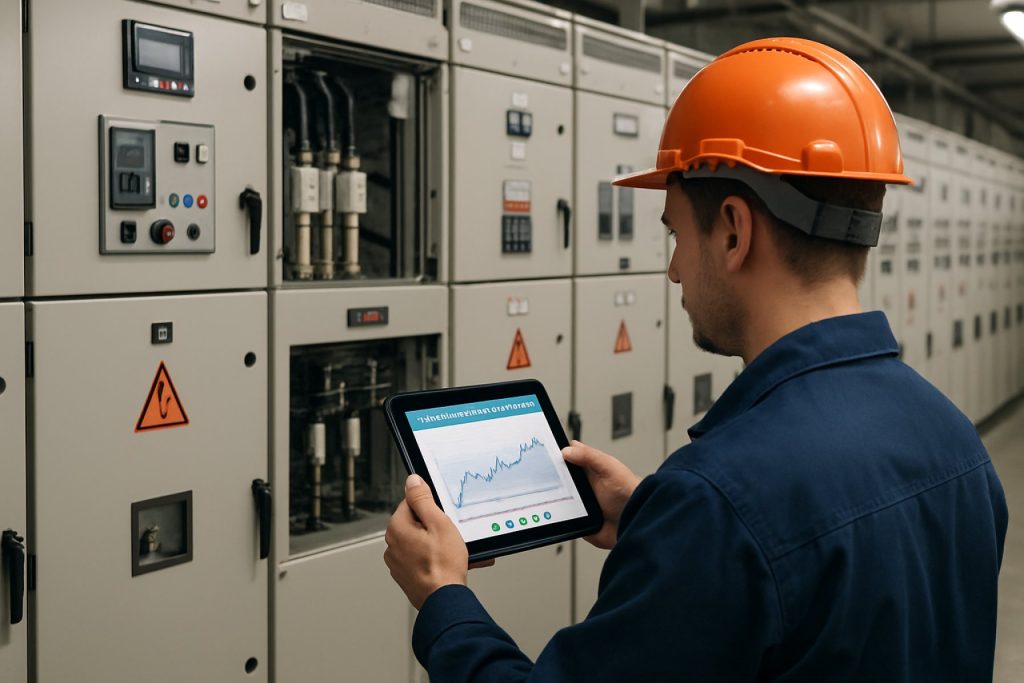
Switchgear Condition Monitoring Systems in 2025: Unleashing Predictive Power for Grid Resilience. Explore How Advanced Analytics and IoT Are Transforming Asset Management and Shaping the Future of Electrical Infrastructure.
- Executive Summary: 2025 Market Outlook and Key Trends
- Industry Overview: The Role of Condition Monitoring in Modern Switchgear
- Technology Landscape: Sensors, IoT, and Data Analytics Innovations
- Competitive Analysis: Leading Manufacturers and Strategic Initiatives
- Market Drivers and Challenges: Digitalization, Grid Modernization, and Cybersecurity
- Regional Insights: Growth Hotspots and Regulatory Influences
- Application Segmentation: Utilities, Industrial, and Commercial Sectors
- Market Forecast 2025–2030: Revenue, Volume, and Adoption Rates
- Case Studies: Real-World Deployments and Measured Benefits
- Future Outlook: Emerging Technologies and Strategic Opportunities
- Sources & References
Executive Summary: 2025 Market Outlook and Key Trends
The global market for switchgear condition monitoring systems is poised for robust growth in 2025, driven by the accelerating digitalization of power infrastructure, heightened focus on grid reliability, and the ongoing integration of renewable energy sources. Utilities, industrial operators, and infrastructure managers are increasingly prioritizing predictive maintenance and real-time asset health monitoring to minimize downtime and extend equipment life. This shift is catalyzing demand for advanced condition monitoring solutions that leverage sensors, Internet of Things (IoT) connectivity, and data analytics.
Key industry players such as Siemens, ABB, and Schneider Electric are at the forefront, offering comprehensive switchgear monitoring platforms that integrate with broader substation automation and asset management systems. These solutions typically monitor parameters such as partial discharge, temperature, humidity, and circuit breaker operation, providing actionable insights for maintenance teams. For example, ABB’s condition monitoring systems are being adopted by utilities to support predictive maintenance strategies and reduce the risk of catastrophic failures.
In 2025, regulatory pressures and industry standards are further shaping the market. Grid operators are required to ensure higher levels of reliability and safety, especially as aging infrastructure faces increased loads from electrification and distributed energy resources. The adoption of IEC 61850 and other digital substation standards is facilitating the integration of condition monitoring data into utility control centers, enabling more proactive asset management.
Data from leading manufacturers indicates a growing trend toward cloud-based and edge-computing solutions, allowing for scalable deployment and remote diagnostics. Siemens and Schneider Electric have both expanded their digital service offerings, enabling utilities to access real-time switchgear health data and analytics via secure platforms. This is particularly relevant for geographically dispersed assets and in regions with limited on-site technical resources.
Looking ahead, the outlook for switchgear condition monitoring systems remains positive, with continued investment expected from utilities, renewables developers, and industrial sectors. The convergence of IoT, artificial intelligence, and advanced sensor technologies is anticipated to further enhance the accuracy and value of monitoring solutions. As the energy transition accelerates and grid complexity increases, condition monitoring will be a critical enabler of resilient, efficient, and sustainable power systems.
Industry Overview: The Role of Condition Monitoring in Modern Switchgear
Switchgear condition monitoring systems have become a cornerstone of modern electrical infrastructure, reflecting a broader industry shift toward predictive maintenance and digitalization. As of 2025, the integration of advanced sensors, data analytics, and real-time communication technologies is transforming how utilities and industrial operators manage the health and reliability of their switchgear assets. The primary role of these systems is to continuously assess the operational status of switchgear—critical components responsible for controlling, protecting, and isolating electrical equipment—thereby minimizing unplanned outages and extending equipment life.
The adoption of condition monitoring is driven by several factors. Aging grid infrastructure in developed regions, coupled with the increasing complexity of power networks due to renewable integration, has heightened the need for proactive asset management. Switchgear failures can result in significant financial losses and safety hazards, making early detection of issues such as partial discharge, insulation degradation, and thermal anomalies essential. Modern systems employ a suite of sensors to monitor parameters like temperature, humidity, gas composition, and electrical signatures, feeding data into centralized platforms for analysis and actionable insights.
Leading manufacturers are at the forefront of this technological evolution. Siemens offers comprehensive condition monitoring solutions that leverage cloud-based analytics and IoT connectivity, enabling remote diagnostics and predictive maintenance scheduling. ABB has developed digital switchgear platforms that integrate real-time monitoring with advanced protection and control features, supporting both medium- and low-voltage applications. Schneider Electric provides EcoStruxure solutions, which combine sensor networks with AI-driven analytics to optimize switchgear performance and reduce operational risks. Eaton and Hitachi Energy are also notable for their investments in digital switchgear and condition monitoring, focusing on modular, scalable systems suitable for diverse grid environments.
Industry bodies such as the IEEE and CIGRE are actively developing standards and best practices to guide the deployment of condition monitoring technologies, ensuring interoperability and data security. The outlook for the next few years points to accelerated adoption, particularly as utilities seek to enhance grid resilience and meet regulatory requirements for reliability and safety. The proliferation of digital substations and the ongoing rollout of smart grid initiatives are expected to further embed condition monitoring as a standard feature in new and retrofit switchgear installations.
In summary, switchgear condition monitoring systems are rapidly evolving from optional enhancements to essential components of modern power systems. Their role in enabling data-driven maintenance, reducing downtime, and supporting the transition to smarter, more resilient grids will only grow in importance through 2025 and beyond.
Technology Landscape: Sensors, IoT, and Data Analytics Innovations
The technology landscape for switchgear condition monitoring systems is rapidly evolving, driven by advances in sensor technology, the proliferation of IoT (Internet of Things) platforms, and the integration of sophisticated data analytics. As of 2025, utilities and industrial operators are increasingly prioritizing real-time monitoring to enhance grid reliability, reduce unplanned outages, and optimize maintenance cycles.
Modern switchgear condition monitoring systems rely on a diverse array of sensors, including temperature, humidity, partial discharge, vibration, and gas sensors. These sensors are becoming more compact, accurate, and energy-efficient, enabling continuous, non-intrusive monitoring of both medium- and high-voltage switchgear. For example, Siemens and ABB have developed integrated sensor suites that can be retrofitted to existing switchgear or embedded in new installations, providing granular data on insulation health, contact wear, and environmental conditions.
The adoption of IoT architectures is a defining trend in 2025. Switchgear monitoring devices are now routinely equipped with wireless communication modules, supporting protocols such as IEC 61850, MQTT, and proprietary industrial IoT standards. This connectivity allows for seamless data aggregation from distributed assets, enabling centralized monitoring and remote diagnostics. Schneider Electric and Eaton are notable for their cloud-based platforms that integrate switchgear data with broader asset management systems, facilitating predictive maintenance and fleet-wide health assessments.
Data analytics and artificial intelligence (AI) are increasingly central to extracting actionable insights from the vast data generated by switchgear monitoring systems. Advanced algorithms can detect early warning signs of insulation degradation, overheating, or mechanical failure, often before traditional maintenance checks would reveal issues. Companies like Hitachi Energy are leveraging machine learning models to correlate sensor data with historical failure patterns, enabling utilities to move from reactive to proactive maintenance strategies.
Looking ahead, the next few years are expected to see further integration of edge computing capabilities, allowing for real-time anomaly detection and decision-making directly at the switchgear site. Enhanced cybersecurity features are also being embedded to protect critical infrastructure from digital threats. As digitalization accelerates, interoperability and standardization efforts—championed by industry bodies such as the IEEE—will be crucial to ensuring seamless data exchange and system scalability across diverse switchgear fleets.
Competitive Analysis: Leading Manufacturers and Strategic Initiatives
The competitive landscape for switchgear condition monitoring systems in 2025 is characterized by a mix of established electrical equipment giants and specialized technology providers, each leveraging digitalization, IoT, and advanced analytics to differentiate their offerings. The market is driven by the growing need for grid reliability, predictive maintenance, and regulatory compliance, especially as utilities and industrial operators modernize aging infrastructure.
Among the global leaders, ABB continues to set benchmarks with its comprehensive portfolio of switchgear monitoring solutions, integrating real-time data acquisition, cloud connectivity, and AI-based diagnostics. ABB’s “Ability” platform exemplifies the trend toward unified asset management, enabling utilities to monitor medium- and low-voltage switchgear health remotely and schedule maintenance proactively. In 2024–2025, ABB has expanded partnerships with grid operators in Europe and Asia to pilot next-generation sensor arrays and edge analytics, aiming to reduce unplanned outages and extend asset lifespans.
Another major player, Siemens, has focused on modular, retrofit-friendly monitoring systems compatible with both new and legacy switchgear. Siemens’ Sensgear and Sensformer lines, equipped with IoT connectivity, have seen increased adoption in North America and the Middle East, where grid modernization projects are accelerating. Siemens is also investing in cybersecurity features and digital twin technology, reflecting customer demand for secure, holistic asset visibility.
Schneider Electric is notable for its EcoStruxure platform, which integrates switchgear condition monitoring with broader energy management and automation solutions. In 2025, Schneider is emphasizing open, interoperable architectures and AI-driven analytics, targeting industrial and commercial customers seeking to optimize operational efficiency and safety. The company’s collaborations with OEMs and digital service providers are expanding the reach of its monitoring solutions into new markets.
Specialist firms such as Eaton and Hitachi Energy are also active, with Eaton focusing on predictive diagnostics for medium-voltage switchgear and Hitachi Energy integrating condition monitoring into its digital substations portfolio. Both companies are leveraging cloud-based analytics and mobile applications to provide actionable insights to field technicians and asset managers.
Strategically, leading manufacturers are prioritizing R&D in sensor technology, edge computing, and AI, while forming alliances with utilities, OEMs, and software vendors. The outlook for the next few years points to intensified competition around interoperability, cybersecurity, and lifecycle service offerings, as end-users demand scalable, future-proof solutions. As digitalization deepens across the power sector, the ability to deliver integrated, data-driven switchgear monitoring will be a key differentiator for market leaders.
Market Drivers and Challenges: Digitalization, Grid Modernization, and Cybersecurity
The market for switchgear condition monitoring systems is being shaped by several converging drivers and challenges, particularly as utilities and industries accelerate digitalization, grid modernization, and address cybersecurity concerns. In 2025 and the coming years, these factors are expected to significantly influence both the adoption rate and the technological evolution of condition monitoring solutions.
Digitalization is a primary driver, as utilities and industrial operators seek to leverage real-time data for predictive maintenance and asset optimization. The integration of Internet of Things (IoT) sensors and advanced analytics into switchgear monitoring enables continuous assessment of parameters such as temperature, partial discharge, humidity, and circuit breaker operation. Major manufacturers like Siemens, ABB, and Schneider Electric have expanded their digital portfolios, offering cloud-based platforms and edge computing solutions that facilitate remote monitoring and diagnostics. For example, ABB’s Ability™ Asset Manager and Siemens’ Sensgear™ are designed to provide actionable insights, reduce unplanned outages, and extend equipment life.
Grid modernization initiatives are also propelling the market. As utilities upgrade aging infrastructure to accommodate distributed energy resources (DERs), electric vehicles, and renewable integration, the need for reliable, intelligent switchgear becomes critical. Condition monitoring systems support these efforts by enabling proactive maintenance and minimizing downtime, which is essential for grid stability. Companies such as Eaton and Hitachi Energy are actively involved in projects that integrate smart switchgear with advanced monitoring, supporting utilities in their transition to more resilient and flexible grids.
However, the increasing connectivity of switchgear assets introduces cybersecurity challenges. As monitoring systems become more networked, they present potential entry points for cyber threats. Industry leaders are responding by embedding cybersecurity features into their solutions, adhering to international standards such as IEC 62443. Schneider Electric and Siemens have both emphasized secure communication protocols and regular software updates as part of their product offerings. Nevertheless, the evolving threat landscape requires continuous vigilance and investment, which can be a barrier for some operators, especially in regions with limited resources.
Looking ahead, the outlook for switchgear condition monitoring systems remains robust, driven by regulatory mandates for reliability, the push for digital transformation, and the imperative to secure critical infrastructure. The market is expected to see further innovation in sensor technology, data analytics, and integrated cybersecurity, with leading manufacturers and utilities setting the pace for adoption and best practices.
Regional Insights: Growth Hotspots and Regulatory Influences
The global landscape for switchgear condition monitoring systems is experiencing dynamic regional shifts, driven by grid modernization, renewable integration, and evolving regulatory frameworks. In 2025 and the coming years, several regions are emerging as growth hotspots, each influenced by distinct policy drivers and infrastructure needs.
Asia-Pacific continues to lead in deployment, propelled by rapid urbanization, industrialization, and ambitious electrification targets. China and India, in particular, are investing heavily in smart grid technologies and grid reliability, with government mandates for predictive maintenance and digitalization of substations. Major utilities and grid operators in these countries are partnering with global and local technology providers to implement advanced monitoring solutions. Companies such as Siemens and ABB have established strong regional presences, offering integrated condition monitoring platforms tailored to local grid requirements.
Europe is witnessing accelerated adoption, underpinned by stringent regulatory standards for grid reliability and decarbonization. The European Union’s focus on energy transition and the integration of distributed energy resources is driving utilities to invest in real-time asset health monitoring. Regulatory bodies are increasingly mandating condition-based maintenance to minimize outages and optimize asset lifecycles. Leading European manufacturers such as Schneider Electric and Siemens are at the forefront, providing modular and scalable monitoring solutions that comply with evolving EU directives.
North America is characterized by modernization of aging grid infrastructure and resilience initiatives in response to extreme weather events. The U.S. Department of Energy and regional regulatory commissions are incentivizing utilities to adopt advanced monitoring and diagnostic systems for critical assets, including switchgear. Utilities are increasingly deploying online monitoring to support predictive maintenance and reduce unplanned outages. Companies like GE Vernova and Emerson Electric are prominent solution providers, collaborating with utilities to implement digital asset management strategies.
In the Middle East and Africa, grid expansion projects and the integration of renewables are creating new opportunities for condition monitoring. Governments are prioritizing grid reliability and operational efficiency, with investments in digital substations and remote monitoring. Global players such as Hitachi Energy are active in the region, supporting utilities with tailored solutions for harsh environmental conditions.
Looking ahead, regulatory influences will remain pivotal. Regions with proactive policy frameworks and incentives for digitalization are expected to see the fastest adoption rates. As utilities worldwide prioritize reliability, safety, and cost optimization, the demand for advanced switchgear condition monitoring systems is set to accelerate through 2025 and beyond.
Application Segmentation: Utilities, Industrial, and Commercial Sectors
Switchgear condition monitoring systems are increasingly being adopted across utilities, industrial, and commercial sectors, each with distinct application drivers and requirements. In 2025, the utilities sector remains the largest adopter, propelled by grid modernization initiatives, regulatory mandates for reliability, and the integration of distributed energy resources. Utilities are deploying advanced monitoring solutions to minimize unplanned outages, extend asset life, and comply with evolving standards for grid resilience. Major utilities are partnering with technology providers to implement real-time monitoring and predictive analytics, leveraging sensors and IoT platforms to track parameters such as partial discharge, temperature, humidity, and circuit breaker operation cycles. Companies like Siemens and ABB are at the forefront, offering comprehensive switchgear monitoring solutions tailored for high-voltage substations and transmission networks.
In the industrial sector, the focus is on ensuring operational continuity and safety in environments where electrical failures can result in significant production losses or safety hazards. Industries such as oil & gas, mining, chemicals, and manufacturing are investing in condition monitoring to support predictive maintenance strategies and reduce downtime. The adoption is further driven by the need to comply with stringent safety regulations and insurance requirements. Schneider Electric and Eaton are notable suppliers, providing modular and scalable monitoring systems that integrate with plant automation and asset management platforms. These solutions enable industrial operators to detect early signs of insulation degradation, contact wear, and thermal anomalies, facilitating timely interventions.
The commercial sector, encompassing data centers, hospitals, airports, and large office complexes, is witnessing growing interest in switchgear condition monitoring as part of broader facility management and energy reliability strategies. The increasing reliance on uninterrupted power for critical operations is prompting facility managers to adopt monitoring systems that offer remote diagnostics and automated alerts. Companies such as Hitachi Energy and Mitsubishi Electric are expanding their offerings to address the specific needs of commercial facilities, including compact, retrofit-friendly solutions and cloud-based analytics.
Looking ahead, the next few years are expected to see accelerated adoption across all segments, driven by digitalization, the proliferation of smart grids, and the growing emphasis on asset health management. The convergence of condition monitoring with AI-driven analytics and cybersecurity features is anticipated to further enhance value propositions, particularly as utilities and industries seek to optimize maintenance costs and improve system reliability. As regulatory frameworks evolve and the cost of sensor technologies declines, switchgear condition monitoring is poised to become a standard feature in new installations and retrofits alike.
Market Forecast 2025–2030: Revenue, Volume, and Adoption Rates
The global market for switchgear condition monitoring systems is poised for robust growth between 2025 and 2030, driven by the accelerating modernization of electrical infrastructure, increasing grid complexity, and the imperative for enhanced reliability and predictive maintenance. As utilities and industrial operators prioritize asset health and operational efficiency, adoption rates of condition monitoring solutions are expected to rise significantly across both developed and emerging markets.
Revenue forecasts for the sector indicate a compound annual growth rate (CAGR) in the high single digits, with global market value projected to surpass USD 3 billion by 2030. This growth is underpinned by large-scale investments in smart grid technologies, the integration of renewable energy sources, and the replacement of aging switchgear assets. Key industry players such as Siemens, ABB, Schneider Electric, and Eaton are expanding their portfolios with advanced condition monitoring solutions, leveraging IoT, cloud analytics, and AI-driven diagnostics to deliver real-time asset insights and predictive maintenance capabilities.
In terms of volume, the deployment of switchgear condition monitoring systems is expected to accelerate, particularly in regions undertaking grid digitalization initiatives. Asia-Pacific, led by China and India, is anticipated to account for the largest share of new installations, reflecting ongoing investments in transmission and distribution infrastructure. Europe and North America are also projected to see steady adoption, driven by regulatory mandates for grid reliability and the need to manage distributed energy resources.
Adoption rates are forecasted to increase most rapidly in medium- and high-voltage segments, where the cost of unplanned outages is highest and the benefits of predictive maintenance are most pronounced. Utilities are increasingly specifying condition monitoring as a standard feature in new switchgear procurements, while retrofit opportunities are expanding as digitalization strategies mature. For example, Siemens and ABB have both reported growing demand for their digital switchgear solutions, which integrate continuous monitoring of partial discharge, temperature, humidity, and other critical parameters.
- By 2027, it is expected that over 40% of new medium- and high-voltage switchgear installations globally will include integrated condition monitoring systems.
- Retrofit adoption is projected to grow at a CAGR above 8% as utilities seek to extend the life of existing assets and reduce maintenance costs.
- Cloud-based and edge analytics platforms are anticipated to become standard, enabling remote diagnostics and fleet-wide asset management.
Overall, the outlook for switchgear condition monitoring systems from 2025 to 2030 is characterized by strong revenue and volume growth, with adoption rates accelerating as digitalization, regulatory pressures, and the need for operational resilience reshape the global power sector.
Case Studies: Real-World Deployments and Measured Benefits
Switchgear condition monitoring systems have seen significant real-world adoption in recent years, with utilities and industrial operators seeking to enhance reliability, safety, and asset longevity. Case studies from 2024 and into 2025 highlight both the technical and economic benefits of these systems, as well as the evolving approaches to deployment and integration.
One notable example is the deployment of online condition monitoring by Siemens for medium- and high-voltage switchgear in European utility networks. By integrating sensors for partial discharge, temperature, humidity, and gas analysis, operators have reported a measurable reduction in unplanned outages and maintenance costs. In a 2024 project with a major German utility, Siemens’ Sensgear™ technology enabled predictive maintenance, resulting in a 30% decrease in emergency repairs and a 15% extension in switchgear service life, according to company-published data.
Similarly, ABB has documented the impact of its Ability™ Condition Monitoring for switchgear in industrial plants across Asia and the Middle East. In a 2023–2024 deployment at a petrochemical facility, ABB’s system provided real-time diagnostics and remote monitoring, which led to a 25% reduction in maintenance-related downtime and improved safety by early detection of insulation degradation. The facility’s maintenance team reported that the system’s data analytics enabled more targeted interventions, optimizing both labor and spare parts inventory.
In North America, Schneider Electric has partnered with several utilities to implement its EcoStruxure™ Asset Advisor platform for switchgear fleets. A 2024 case study from a Canadian utility demonstrated that continuous monitoring and cloud-based analytics allowed for the early identification of thermal anomalies and contact wear, preventing at least two potential failures in the first year of operation. The utility estimated a return on investment within 18 months, primarily through avoided outages and reduced emergency callouts.
Looking ahead to 2025 and beyond, these case studies underscore a clear trend: utilities and industrial operators are moving from periodic, manual inspections to continuous, data-driven asset management. The integration of condition monitoring with digital platforms and remote diagnostics is expected to accelerate, especially as more switchgear assets reach mid-life and as regulatory pressures for reliability and safety increase. Major manufacturers such as Hitachi Energy and Eaton are expanding their offerings, with new deployments anticipated in both developed and emerging markets. The measured benefits—reduced downtime, lower maintenance costs, and improved safety—are likely to drive further adoption through 2025 and the following years.
Future Outlook: Emerging Technologies and Strategic Opportunities
The future of switchgear condition monitoring systems is being shaped by rapid advancements in digitalization, sensor technology, and data analytics, with 2025 poised as a pivotal year for the sector. Utilities and industrial operators are increasingly prioritizing predictive maintenance and real-time asset management, driven by the need to enhance grid reliability, reduce downtime, and optimize operational costs. This shift is catalyzing the adoption of advanced condition monitoring solutions that leverage the Industrial Internet of Things (IIoT), artificial intelligence (AI), and cloud-based platforms.
Key industry players are investing heavily in R&D to develop next-generation monitoring systems. ABB has introduced digital switchgear solutions that integrate continuous online monitoring of critical parameters such as temperature, humidity, partial discharge, and circuit breaker health. These systems utilize edge computing and secure connectivity to provide actionable insights, enabling operators to move from scheduled to condition-based maintenance. Similarly, Siemens is advancing its Sensgear and Sensformer portfolios, embedding IoT sensors directly into switchgear to facilitate real-time diagnostics and remote asset management.
The integration of AI and machine learning is expected to further transform the landscape by enabling predictive analytics and automated anomaly detection. Schneider Electric is actively developing cloud-enabled platforms that aggregate data from multiple switchgear assets, applying advanced algorithms to predict failures and recommend maintenance actions. This approach not only extends equipment life but also supports the broader digital transformation of substations and industrial facilities.
Cybersecurity is emerging as a critical consideration, as the proliferation of connected devices increases the attack surface. Industry leaders are collaborating with standards organizations to implement robust security protocols and ensure compliance with evolving regulations. The adoption of open communication standards, such as IEC 61850, is facilitating interoperability and integration with existing SCADA and asset management systems, further accelerating market growth.
Looking ahead, the market for switchgear condition monitoring systems is expected to expand significantly through 2025 and beyond, driven by grid modernization initiatives, renewable energy integration, and the electrification of transport and industry. Strategic opportunities exist for manufacturers and utilities to leverage digital twins, augmented reality for maintenance, and advanced analytics to unlock new value streams. As the sector evolves, partnerships between OEMs, utilities, and technology providers will be crucial in delivering scalable, secure, and future-proof solutions.



